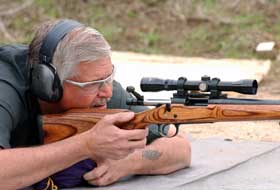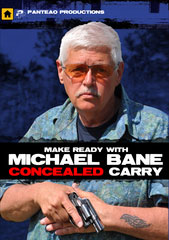
Re: Stopping power, part of yesterday's post, I thought I might expand a bit on the topic and maybe discuss it in today's belated podcast. I'm of the "if you have to shoot, shoot them repeatedly" school. I like the 9mm because I can deliver multiple hits more quickly than I can with a .45. Not a huge amount of difference, but a real one. The thing I'm most interested in is the effect of both the shooter's and the shootee's expectations during the violent event. From a shooter standpoint, any expectation of a "one-shot stop" seems to me to be a major negative, because the shooter might hesitate after the first shot to see whether the threat is actually ended. That tiny hesitation could be fatal if the threat indeed isn't ended.
A far better solution is the one used by a veteran shooter down South recently during a "hot" home invasion. He was sitting in his living room, gun on, when the 2 home invaders kicked in his front door. The good guy hit the first man through the door with 7 rounds from his Glock .45 GAP; the second home invader reconsidered his career choices and beat feet out of there.
Regarding expectations on the part of the shootee, I think this is a bigger issue than many people believe. Way back 20 some-odd years ago, when I first went through Mas Ayoob's LFI, Mas talked about what happens to people when they're shot...some fall down and die when they shouldn't have; some keep right on fighting and die later...sometimes much later.
How much of a role does expectation play in a Real World shootings? For years my mentor Walt Rauch has said that a criminal's "job description" includes having guns pointed at him or her and even being shot. Plus, professional life-long criminals have either been shot themselves or had friends or associates who were shot — and they didn't explode, suddenly become vaporized, be flung through walls, etc. They recovered.
The stats show that most people who are shot recover — I've seen stats as high as 85%. I know those stats on an intellectual basis, but the criminal knows them on a guy level. I also know, and professional criminals know, that in a street gunfight, most shots miss their targets entirely.
What does that tell the criminal about being shot, the violent criminal actor equation, if you will? Here's what I think it tells the criminal...most "citizens" won't shoot, and if you get the exception to the rule, they're likely to miss anyway...and if you do get hit, it's not likely to kill you...and if you do get killed, hey, you could have gotten hit by a bus on the same day! The odds of "winning" are in the criminal's favor.
When I was up at Threat Dynamics, I noted that they use a Taser belt, which can register shots to the trainee at various levels of pain, to teach people to "fight through" being wounded. Seems like a smart training move to me...I'll probably expand on this in today's podcast...
BTW, this exceptionally good Quip on training from Brother John Farnam at DTI sums it up better than I can:
16 Nov 09
Scenario-Based Training:
We just completed an Airsoft-enabled, Scenario-Based Training program in
Addison, IL, at the wonderful Safe Direction facility. It was an eye-opener
for all of us!
Students were veterans of several Defensive Handgun Programs, by us and
other well-known instructors. All carry concealed regularly. No amateurs
were present!
We used Airsoft pistols and rifles, and all students were thoroughly
oriented on Airsoft at the beginning of the Program.
Here are important lessons students report over and over:
1) Keep your head up! Maintain continuous visual contact with all
possible threats. Look all around. Notice details. Gawking at your gun seldom
provides you with any useful information.
2) Stay in motion! We die in the gaps. Get off the "X!"
3) Use cover! Be ever-aware of objects that may be used for cover. Be
able to become an extremely difficult/illusive target, instantly.
4) Develop an ability to rapidly size-up threatening situations. We may
not like what we see, but we must have the personal courage to confront
indisputable facts squarely.
5) Have a plan! You must have a tactical blueprint up on your screen all
the time. You can't plan every detail, but you must have a general idea of
what you're going to do and where/how you're going to start.
6) Be able to distinguish the significant from the insignificant! Most
information is worthless. Don't expend attentive energy on what is not
important. Quickly determine what is critical and start planning around it.
Beware of decoys!
7) Don't panic! Move smoothly and with purpose. No wasted parts; no
wasted motions! Control your breathing and stay one step ahead of developing
situations. Use your sights; aim your shots!
8) Fight through speed-bumps. Running out of ammunition, stoppages, being
wounded, et al. They're all just speed-bumps. Don't turn them into Mt
Everest! Get over/around them quickly and move on.
9) Gain and maintain the offensive! Turn the table on your opponent(s)
immediately. Once the initiative is seized, never give it up. Stay in
control. One-by-one, eliminate his options.
10) Finish the fight! Outcomes are often determined by who gives up
first. See the fight through to the end.
11) Don't hesitate, dither, nor stampede! (a) Smooth, (b) lethally
potent, (c) coldly efficient, (d) surgically precise, and (e) ruthlessly
incisive execution are the keys to victory.
Scenario-based training represents a wonderful opportunity to exercise all
of the foregoing.
We're doing a lot of it these days!
/John






12 comments:
Very helpful comments...looking forward to hearing more on the podcast. Thanks again.
Bravo!
Ratcatcher 55
Good points! Just this week, I think it was, Number 9; Taking the offensive and maintining control", was implemented by real live citizens. It seems that the Maersk Alabama, the freight ship that was hijacked off of somalia earlier this year was, you guessed it, attacked again by Somali pirates. Only this time, the ship had "security people" on board that were armed! The security staff opened fire on the pirates, sending them scurrying back across the open ocean. The taking of an offensive position as an immediate defense worked. Also of importance, armed citizens in a formerly gun-free zone prevailed. They were no longer sitting ducks. It's what my dad taught me about fighting. If the attacker wants trouble, give it to him right then. It will usually put you in control. You of course, have to keep the control.
Life Member
Some folks think movies and TV "desensitize" kids to violence. But I'm wondering if the converse is true: mebbe they sensitize kids to think that the handgun is omnipotent - shoot once and you win; get shot once and you die.
This is an excellent topic to emphasize on Best Defense, methinks!
Think "zombie" when in a shootout - assume the BG will keep coming at you (mebbe he will) until you put him down and out.
Zombieland, a movie to correct the sensitizing of our youth to the "omnipotent handgun" myth?
I speak only from theory, as I've not actually seen The Elephant, and hope I never do.
If there is anybody out there who has seen the Elephant, I would almost pay good money to hear or read an honest, without editorial or male bravado embelishment, after action report.
After all the smoke cleared, did the guy go:
A. "Gee, I sure wish I had a 9mm because I could have delivered more, smaller bullets in quick succession."
ORRRRRRRR!!!!
B. "Man, I wish I had .45 ACP instead of that little mouse-gun 9mm."
Until a time comes when I actually meet a guy who has seen this Elephant...all this talk about stopping power and speed...seems...well...just so much mental masturbation to me.
Oh, and by the phrase "seeing the Elephant", I mean for real legitimate police reports and news broadcasts or stories to back it up.
Sigh.....
Clark, I think that you're onto something there. I strongly believe that video games tend to give a false sense of security to players. Things in the real world don't usually work out as in the games. Unfortunately, I also strongly believe that this phenomenon extends into the so called "real life" training offered by many tactical schools, as good as they are. When I watch the many scenarios that are played out in the "shoot-houses" and on the range, I can see where graduates WILL get the same false sense of security, especially since those targtes don't shoot back! The only way that you really learn to fight is by actually fighting and by getting hit, stabbed, or shot. Oh yeah, and hurt. That's why the military has the new non-lethal "practice" ammo available to them only, that allows trainees to actually shoot at each other and actually get shot, with actual combat weapons.
I think that the next successful trainer will take civilian training to this level. While you may not be able to get the newest training ammo, you will be able to develop training courses that are focused on actually fighting with other non-lethal tools.
Life Member
All this talk of non-lethal this and non-lethal that has my head spinning. Kinda makes me think of tazers and mace and collapsible batons and bean bag shotties...
Let me coin a new term for these new training tools:
Pseudo-lethal.
Yeah, that's it, pseudo-lethal.
I think that the an individual criminals mental reaction to being shot is is a big and unknowable part of the equation that makes a great deal of the handgun stopping power debate pointless. When shot some people are going to surrender, or run away, or drop dead, or keep on fighting no matter what caliber/load you shoot him with.
And just as a lot of what we "knew" about handgun stopping power 15-20 years ago is now considered nonsense, I'm sure that a lot of what we "know" today will be considered bunk 20 years from now.
Actually, the stuff isn't called "non" lethal. It's sold as "less" lethal and the training that's given to officers who are issued it emphasizes this distinction.
Hunters (and guides) call it "admiring the shot" - when said hunter/shooter should prepping for the next (and next, next,... A.I.) shot. Buddy of mine was a Platoon SGT in Iraq in '06. Two of his biggest training issues were soldiers expecting Hollywood results on bad guys and, you guessed it, "admiring the shot" instead of shooting again.
that was sarcasm about my pseudo lethal comments. Yeah, I already knew about the less lethal designation, but in some cases, training isn't enough and can lead to some very catastrophic results.
Sorry, my sarcasm doesn't come through very well on the internet. At least not without a:
:-)
or a :
:-P
there might still be a niche for my pseudo-lethal, training related term though. ;-)
15 to 20 years ago there weren't so many wonder 9 semi-auto pistols in police officers's hands. Plus, there weren't as many video cameras around like now to capture super-sonic events as they unfold, which can now be better analyzed in slow-mo .
And video is so more impartial and so more accurate than any other witness's memory...which can be biased...or mis-led.
Post a Comment